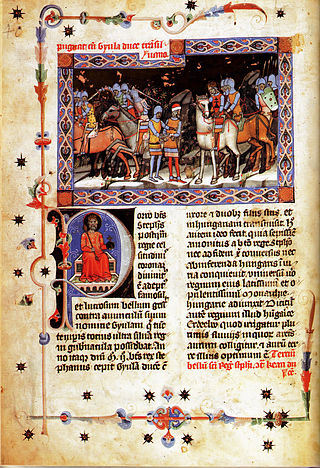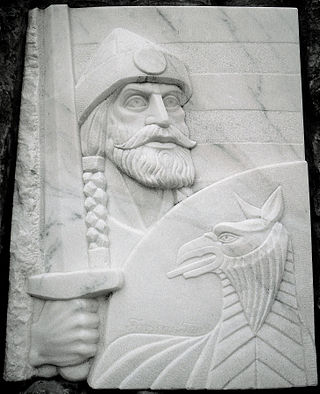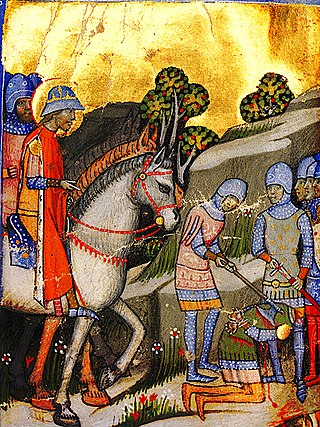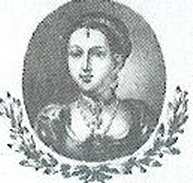
Géza, also Gejza, was Grand Prince of the Hungarians from the early 970s. He was the son of Grand Prince Taksony and his Oriental—Khazar, Pecheneg or Volga Bulgarian—wife. He married Sarolt, a daughter of an Eastern Orthodox Hungarian chieftain. After ascending the throne, Géza made peace with the Holy Roman Empire. Within Hungary, he consolidated his authority with extreme cruelty, according to the unanimous narration of nearly contemporaneous sources. He was the first Hungarian monarch to support Christian missionaries from Western Europe. Although he was baptised, his Christian faith remained shallow and he continued to perform acts of pagan worship. He was succeeded by his son Stephen, who was crowned the first King of Hungary in 1000 or 1001.

Stephen I, also known as King Saint Stephen, was the last grand prince of the Hungarians between 997 and 1000 or 1001, and the first king of Hungary from 1000 or 1001 until his death in 1038. The year of his birth is uncertain, but many details of his life suggest that he was born in, or after, 975, in Esztergom. He was given the pagan name Vajk at birth, but the date of his baptism is unknown. He was the only son of Grand Prince Géza and his wife, Sarolt, who was descended from a prominent family of gyulas. Although both of his parents were baptized, Stephen was the first member of his family to become a devout Christian. He married Gisela of Bavaria, a scion of the imperial Ottonian dynasty.

Taksony was the Grand Prince of the Hungarians after their catastrophic defeat in the 955 Battle of Lechfeld. In his youth he had participated in plundering raids in Western Europe, but during his reign the Hungarians only targeted the Byzantine Empire. The Gesta Hungarorum recounts that significant Muslim and Pecheneg groups settled in Hungary under Taksony.
The Árpád dynasty consisted of the members of the royal House of Árpád, also known as Árpáds. They were the ruling dynasty of the Principality of Hungary in the 9th and 10th centuries and of the Kingdom of Hungary from 1000 to 1301. The dynasty was named after the Hungarian Grand Prince Árpád who was the head of the Hungarian tribal federation during the conquest of the Carpathian Basin, c. 895. Previously, it was referred to as the Turul dynasty or kindred.

Gyula was, according to Muslim and Byzantine sources, the title of one of the leaders, the second in rank, of the Hungarian tribal federation in the 9th–10th centuries. In the earliest Hungarian sources, the title name is only recorded as a personal name.

Fajsz, also Falicsi, was Grand Prince of the Hungarians from about 950 to around 955. All information on him comes from De administrando imperio, a book written by the Byzantine Emperor Constantine VII Porphyrogenitus. No other contemporary source or later Hungarian chronicle preserved his name, suggesting that he did not take an active role in the politics of the Hungarian tribes' confederation.

Koppány, also called Cupan was a Hungarian lord in the late 10th century and leader of pagans opposing the Christianization of Hungary. As the duke of Somogy, he laid claim to the throne based on the traditional idea of seniority, but was defeated and executed by Stephen, son of the previous grand prince Géza.
Grand Prince was the title used by contemporary sources to name the leader of the federation of the Hungarian tribes in the tenth century.

Anastasia of Kiev was Queen of Hungary by marriage to King Andrew the White.

Richeza of Poland was Queen of Hungary by marriage to Béla I, King of Hungary.
The Duchy or Ducatus is the denomination for territories occasionally governed separately by members (dukes) of the Árpád dynasty within the Kingdom of Hungary in the 11th-12th centuries. The symbol of the ducal power was a sword, while the royal power was represented by the crown.

Judith of Hungary was a Hungarian princess and member of the Árpád dynasty. She was briefly married to the Piast duke of Poland, Bolesław the Brave.
Gyula III, also Iula or Gyula the Younger, Geula or Gyla, was an early medieval ruler in Transylvania. Around 1003, he and his family were attacked, dispossessed and captured by King Stephen I of Hungary (1000/1001-1038). The name "Gyula" was also a title, the second highest rank in Hungarian tribal confederation.
Zombor, also referred to as Gyula II or Gylas, was a Hungarian tribal leader in the middle of the 10th century. He visited Constantinople, where he was baptized in 952 with the baptismal name of Stephen.
Géza was a Hungarian royal prince and the youngest son of the King Géza II of Hungary. Prince Géza was brother to the Kings Stephen III and Béla III of Hungary. He was a pretender to the Hungarian throne against Béla III, but he was imprisoned from 1177 to 1189. He traveled to the Holy Land during the Third Crusade with an army of 2,000 Hungarian warriors.

Osl was the name of a gens with Hungarian origin in the Kingdom of Hungary, based in today's Győr-Moson-Sopron County and in the Banate of Severin. The village of Osli was named after that clan. Also the Oslea mountain in the former Banate of Severin.

Michael was a member of the House of Árpád, a younger son of Taksony, Grand Prince of the Hungarians. Most details of his life are uncertain. Almost all kings of Hungary after 1046 descended from him.
Zerind the Bald was a Hungarian lord in the 10th century. According to modern scholars' consensus, he was a member of the royal Árpád dynasty. He was the father of Koppány, the late 10th-century rebellious Duke of Somogy.
The longer version of the Life of Saint Stephen, King of Hungary is one of the three hagiographies of Saint Stephen, who was crowned the first King of Hungary in 1000 or 1001. It was written between 1077 and 1083, before King Stephen I's canonization.
Bogát was a 10th century Hungarian General, according to Liudprand, Bogát was one of the leaders of the 921–922 Italian Campaign under the name Busak. According to László Makkai, he then became the first Gyula of Transylvania. Gyula Kristó explains the origin of his name from the Slavic word ("rich").







